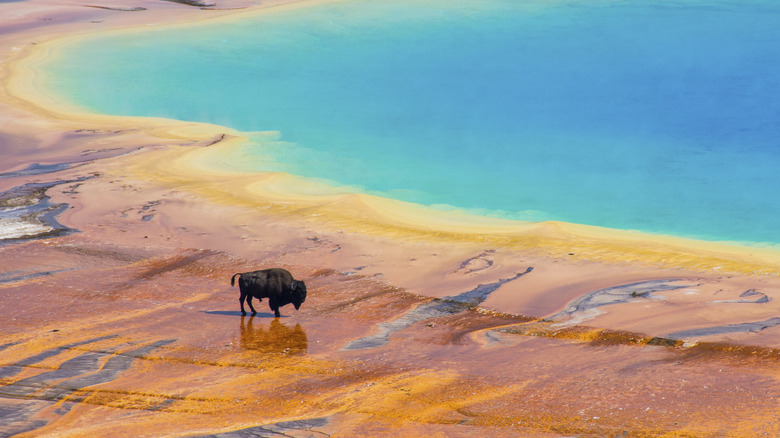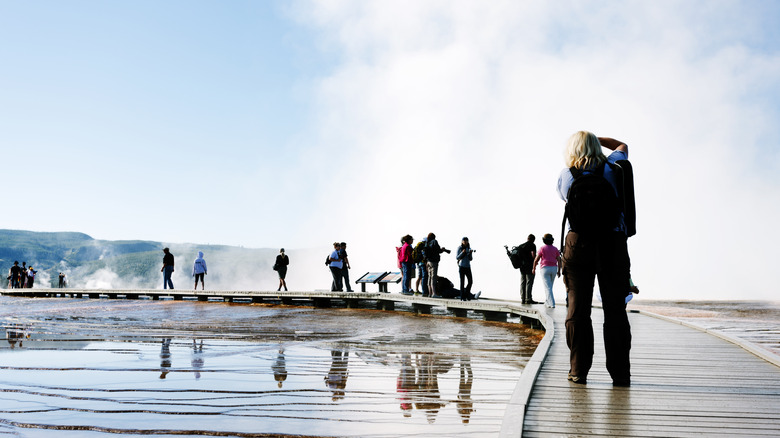Travel Guides Outdoor Adventures
Caitlyn Knuth
In a world filled with photo editing and touch-ups, it can be hard to know what’s real and what’s altered. That said, there are places out there designed by nature that simply don’t need retouching of any kind when it comes to captivating color saturation. One place that houses a truly breathtaking natural wonder of this type is Yellowstone National Park.
According to Yellowstone Forever, Yellowstone National Park is home to no less than 500 active geysers, 285 bird species, and more than 1,000 miles of hiking trails too. It’s fair to say there’s plenty to enjoy and explore here including the park’s more than 10,000 hydrothermal features. Among them is the country’s largest hot spring which also happens to be a breathtaking kaleidoscopic hot spring known as Yellowstone’s Grand Prismatic Spring.
The Grand Prismatic Spring is vast and certainly impressive to behold. However, it’s the eye-catching shades of vivid reds, blues, greens, and yellows on display that inevitably captivate observers with good reason. It’s rare to see such a brilliant combination of colors in one location in nature, and yet, Yellowstone National Park is proud to provide visitors with opportunities to relish this view year-round.
Many wonder just how Mother Nature manages to create such a gorgeous spectacle without needing any help from technology. The truth of this breathtaking kaleidoscopic hot spring comes down to the bacteria, thermophiles, and algae that are strong enough to withstand such a harsh and hot environment. In combination, they create an unforgettable sight.
The science behind the kaleidoscopic colors

Megan Brady/Getty Images
There’s something inspiring about the Grand Prismatic Spring’s collection of color bands. Similar to all hot springs, the Grand Prismatic Spring is the result of hot water moving up through cracks in the Earth’s surface. Without obstruction, the water cycles between heating and cooling creating various temperature bands as it moves through its course.
The Grand Prismatic Spring is 370 feet across and water at the center reaches temperatures of around 189 degrees Fahrenheit. At this temperature, life isn’t sustainable leaving the water clear and blue. As the water moves away from the center of the spring, it begins to cool, and depending on what type of bacteria can exist at varying temperatures, observers will see an associated and unique color band.
One type of organism that lives within the spring and contributes to these fascinating colors is a bacteria known as Synechococcus. Categorized as a cyanobacterium that uses photosynthesis for energy, this bacteria is extremely durable in harsh conditions. Synechococcus is responsible for the gorgeous yellow hue within the spring.
Water continues to cool as it moves away from the yellow band providing an environment that can support a bacteria known as Chloroflexi. These are the bacterium responsible for the orange band of color in the spring. The red band which is the furthest from the center is also the coolest at around 131 degrees Fahrenheit. It’s home to a variety of bacteria that combined, create this unique and gorgeous hue.
Planning your colorful visit

Urbancow/Getty Images
Yellowstone National Park is a vast place and making sure you get the opportunity to set your sights on the Grand Prismatic Spring might require some planning. The simplest way to access the spring is to set your route for Midway Geyser Basin. There’s convenient parking in this area as well as a south-heading trail toward the Firehole River. Follow the trail and it will take you to a viewing area around the Grand Prismatic Spring.
For an even more breathtaking vantage point, Yellowstone visitors can opt for a hike up the Midway Bluff Trail. This trek comes with the reward of a bird’s eye view over the Grand Prismatic Spring as well as the Midway Basin and the Excelsior Geyser Crater too. It’s a stop that promises to be photo-worthy and you’ll want to have your camera ready to go.
When you return to ground level, you can take time to stroll along the boardwalk that circles the Grand Prismatic Spring for varying angles and views of this colorful natural wonder. Grand Prismatic also sits within easy reach of nearby springs like the Turquoise Pool and the Opal Pool, both of which can be reached using the boardwalk.

